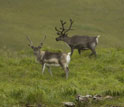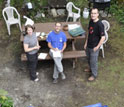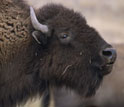News Release 11-235
Large Ice-Age Mammal Extinctions: Humans and Climate the Culprits
Findings may foreshadow possible fates of living species

Many, but not all, ice-age mammals went extinct due to climate change and human influences.
November 2, 2011
This material is available primarily for archival purposes. Telephone numbers or other contact information may be out of date; please see current contact information at media contacts.
The histories of six large herbivores--the woolly rhinoceros, woolly mammoth, wild horse, reindeer, bison and musk ox--are linked with climate fluctuations and human activity, especially at the end of the last ice age, scientists find in a new report.
Research led by evolutionary biologist Eske Willerslev of the Centre for GeoGenetics at the University of Copenhagen along with an international team of paleontologists, geologists, geneticists and climate modelers suggests early humans and changing climate were responsible for the extinction of some cold-adapted animals, and the near-extinction of others.
The journal Nature published the results of the study this week. It was the first to use genetic, archaeological and climate data to infer the population history of large-bodied ice age mammals.
"The combination of approaches in this study--including the most modern molecular tools and painstaking fieldwork--sheds a powerful light on the complex interactions of humans, ecosystems and climate," said Hedy Edmonds, arctic natural sciences program director in the National Science Foundation's (NSF) Office of Polar Programs, Division of Arctic Sciences.
The results carry a message about the possible fates of living mammals as Earth continues to heat up.
"Our findings put a final end to single-cause theories of these extinctions," said Willerslev.
"Our data suggest care should be taken in making generalizations regarding past and present species extinctions," he said. "The relative impacts of climate change and human encroachment on species extinctions really depend on which species we're looking at."
"We couldn't pinpoint what patterns characterize extinct species, despite the large and varying amount of data analyzed," said scientist Eline Lorenzen of the University of Copenhagen, the first author of the paper.
"This suggests that it will be challenging for experts to predict how existing mammals will respond to future global climate change--to predict which species will go extinct and which will survive."
Beth Shapiro, a biologist at Penn State University whose research for the project was funded by NSF, explained that all six of the studied species flourished during the Pleistocene Epoch--the period of geologic time that lasted from about two million to 12,000 years ago.
"During this time, there were lots of climate ups and downs--oscillations between long, warm intervals called interglacial periods, during which the climate was similar to what we have today, followed by long, cold intervals called glacial periods, or ice ages.
"Although cold-adapted animals fared better during the colder glacial periods, they still managed to find places where the climate was just right--refugia--to survive during warmer interglacial periods.
"Then after the peak of the last ice age around 20,000 years ago, their luck started to run out."
What changed?
To find answers, Shapiro and colleagues tested hypotheses about how, when and why the woolly rhinoceros, woolly mammoth and wild horse went extinct after the last ice age and why the reindeer, bison and musk ox were able to survive--albeit in more restricted ranges than during the ice ages.
"One source of information we used was DNA from the animals themselves," Shapiro said. "With genetic data, it's possible to estimate when and how much populations were able to grow and shrink as the climate changed and their habitat started to disappear."
The scientists also collected climate data--temperature and precipitation patterns--from both glacial and interglacial periods, as well as archaeological data, which they used to study the extent to which early humans may have influenced the survival of these species.
"For example, in locations where animal bones had been cooked or converted into spears, we know that humans lived there and were using these mammals as a resource," Shapiro said.
"Even where we didn't find evidence that humans were using the animals, if they lived in the same place and at the same time, humans could have had some influence on whether the animals survived or not."
In the case of the now-extinct woolly rhinoceros, the scientists found that in Europe the ranges of humans and woolly rhinoceros never overlapped.
"These data suggest that climate change, and not humans, was the main reason why this particular species went extinct in present-day Europe," Shapiro said.
"We expect, though, that humans might have played a role in other regions of the world where they did overlap with woolly rhinos."
Much clearer was the evidence that humans influenced, and not always negatively, the population sizes of the five other species in the study--the woolly mammoth, wild horse, reindeer, bison and musk ox.
Population fluctuations for all six species continued until around 14,000 years ago when many of the species simply disappeared at the end of the last ice age.
"The take-home message is that during the most recent warming event, when the last ice age faded into the warm interval we have today, something kept these animals from doing what they had always done, from finding alternative refugia--less-than-ideal, but good-enough chunks of land on which to keep their populations at a critical mass," Shapiro said.
"That 'something' was probably us."
During the time when the animals were declining, the human population was beginning its boom, and was spreading out across not only the large-bodied mammals' cold-climate habitats, but across their warm-climate refuges, changing the landscape with agriculture and other activities.
Many large-bodied, cold-adapted mammals, including the horse--which is considered extinct in the wild and now survives only as a domesticated animal--suddenly had no alternative living spaces, and, as such, no means to maintain their populations.
"The results of our study suggest that although past warm periods caused these animal species to go through periodic bottlenecks--evolutionary events during which the size of a population diminishes substantially and stays small for a long time--they always seemed to bounce back, and to return to their previous habitats as soon as Earth became cooler again," Shapiro said.
"Then, during the most-recent warming cycle, the trend changed."
As the climate became warmer after the last ice age, the woolly rhinoceros, woolly mammoth and wild horse went extinct, but the reindeer, bison and musk ox survived.
Reindeer managed to find safe habitat in high arctic regions where today they have few predators or competitors for limited resources.
Bison are extinct in Asia, where their populations were extensive during the ice ages, and now are found only in North America, although a related species survives in small numbers in Europe.
Cold-adapted musk oxen live only in the arctic regions of North America and Greenland, with small introduced populations in Norway, Siberia and Sweden.
Interestingly, if humans had any impact on musk ox populations, it may have been to help sustain them. Musk ox populations first became established in Greenland around 5,000 years ago, after which they expanded rapidly, despite having been a major food resource for the Paleo-Eskimo population.
Today, the species survives in large numbers.
These findings could help predict the fate of mammal populations threatened by present-day climate change and habitat alteration.
"The results provide direct evidence that something changed between the most-recent glacial cycle, when many of these species went extinct, and previous glacial cycles, through which they all managed to survive," said Shapiro.
"Although it's clear that climate change drives the dynamics of these species, we, as humans, have to take some of the blame for what happened during this most recent cycle."
Our ancestors, it seems, were able to change the landscape so dramatically, said Shapiro, that these animals were effectively cut off from what they needed to survive, even when the human population was small.
"There are many more humans today," she said, "and we have changed, and are continuing to change, the planet in even more important ways."
In addition to Shapiro, Willerslev and Lorenzen, many other scientists contributed to the research. They are from Denmark, Australia, Sweden, Spain, the United Kingdom, the Netherlands, Germany, Norway, Russia, China, Canada and the United States. U.S. co-authors are from institutions in Utah, California, Texas, Missouri, Maryland, Colorado, Massachusetts, Oregon and Kansas.
The Leverhulme Trust, the Awards Fund, the Danish National Research Foundation, the Lundbeck Foundation and the Danish Council for Independent Research also funded the research.
-NSF-
-
In their research, scientists looked at ice-age mammal DNA and at long-term climate records.
Credit and Larger Version -
Ancient bones, yes, but the tale of extinction they tell may reach into the present.
Credit and Larger Version -
While many ice-age mammals went extinct, some are still with us, thriving in northern climes.
Credit and Larger Version -
The bones of many large mammals lie before scientists, a result of extensive field work.
Credit and Larger Version -
Can the few ice-age mammal species left find "refugia" in today's warming world?
Credit and Larger Version
Media Contacts
Cheryl Dybas, NSF, (703) 292-7734, email: cdybas@nsf.gov
Barbara Kennedy, PSU, (814) 863-4682, email: science@psu.edu
The U.S. National Science Foundation propels the nation forward by advancing fundamental research in all fields of science and engineering. NSF supports research and people by providing facilities, instruments and funding to support their ingenuity and sustain the U.S. as a global leader in research and innovation. With a fiscal year 2023 budget of $9.5 billion, NSF funds reach all 50 states through grants to nearly 2,000 colleges, universities and institutions. Each year, NSF receives more than 40,000 competitive proposals and makes about 11,000 new awards. Those awards include support for cooperative research with industry, Arctic and Antarctic research and operations, and U.S. participation in international scientific efforts.
Connect with us online
NSF website: nsf.gov
NSF News: nsf.gov/news
For News Media: nsf.gov/news/newsroom
Statistics: nsf.gov/statistics/
Awards database: nsf.gov/awardsearch/
Follow us on social
Twitter: twitter.com/NSF
Facebook: facebook.com/US.NSF
Instagram: instagram.com/nsfgov







